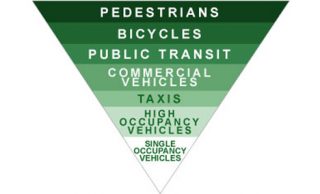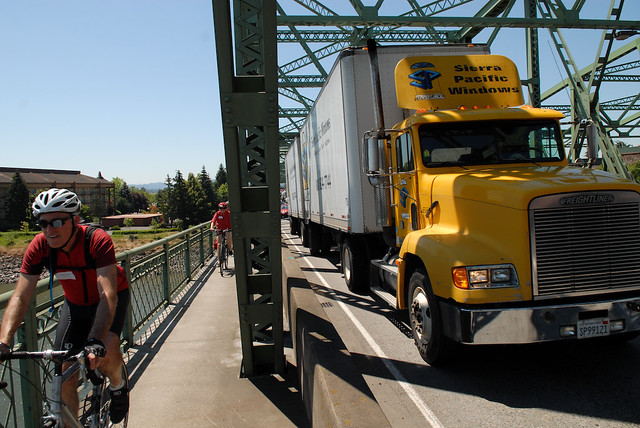
maybe the city’s single most progressive statement of
transportation policy.
The City of Portland says (PDF) its new 20-year comprehensive plan is informed by three city documents that created a prioritized ranking for transportation needs.
But it’s an open question whether the “green transportation hierarchy,” as it’s been known since its creation in 2009, will be fully enshrined in the 20-year comprehensive plan as it previously was in the Sam Adams-era Climate Action Plan, Bicycle Plan for 2030 and Portland Plan.
Members of the city’s Bicycle Advisory Committee are making it one of their top requests to the city to keep the chart in place and intact.

The chart is, of course, just a chart. As recently as last summer, the city was proposing to spend $30,000 to narrow a sidewalk in a commercial area in order to preserve three on-street car parking spaces next to an unused offstreet private parking lot.
But the transportation hierarchy is seen as a powerful enough idea that some freight advocates have urged for the “commercial vehicles” category, currently ranked below “public transit” and above “taxis,” to be removed from the priority list.

(Photo: J.Maus/BikePortland)
“Commercial vehicles kind of don’t really fit into a green hierarchy. or if you did put them into a green hierarchy they’d probably fit at the top of the pile,” said Corky Collier, executive director of the Columbia Corridor Association of freight customers. “They’re moving a lot of goods and services very efficiently.”
In the end, Collier said there’s no hierarchy that can usefully weigh moving a 150-pound person against moving 150 pounds of commercial goods.
But biking advocates like Ian Stude, chair of the city’s Bicycle Advisory Committee, and Rob Sadowsky, executive director of the Bicycle Transportation Alliance, argue that the interests of commercial vehicles often need to be weighed against other priorities.
Advertisement
“The green hierarchy is not just about environmental green,” Sadowsky said Tuesday. “It is about keeping traffic moving, about successful business districts and about safety.”
The conversation comes as the city’s Planning and Sustainability Commission is asking for public input on the city’s 20-year comprehensive plan, which this year is due for its first update since the 1980s. As part of its outreach process, the city is asking residents and other stakeholders to sift through 83 pages of online transportation project lists to select their five most important projects.
For example, there’s project 40109, a neighborhood greenway on NE 14th Avenue between Halsey and Lombard, expected to cost $774,000 and be built sometime in the late 2020s or early 2030s, or project 50015, “Gateway 99th/96th streetscape improvements,” which would “reconstruct primary local main street in Gateway Regional Center.” That’s expected to cost $4.9 million and happen in the next 10 years.
Like the city’s Bicycle Plan for 2030 (which was one of many documents the city used to help build this list), there’s no money attached to these plans. The purpose of this ranking is to help the city decide which projects to try to find money for.
If you’d like to participate in the city’s “top five” exercise, you can find your favorites in the project lists on this page and emailing them (with your name and home address) to PSC@portlandoregon.gov and TSP@portlandoregon.gov. Alternatively, you can submit comments through the city’s map app, or testify in person at a hearing this evening or by mail. Here are the city’s instructions (PDF) on how to do those things.
That’d also be a way to share feelings on the city’s transportation hierarchy.

